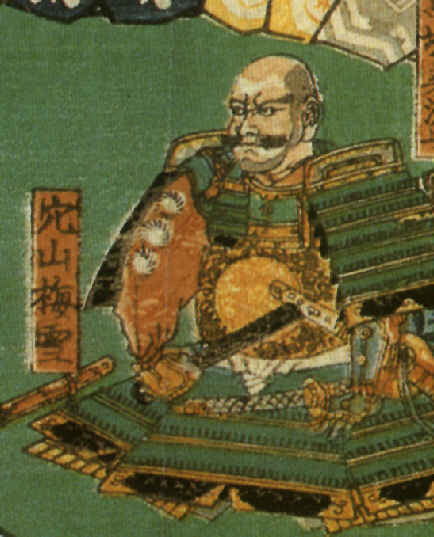Anayama Baisetsu on:
[Wikipedia]
[Google]
[Amazon]
 , also known as Anayama Genba Nobukimi (in ''Chronicle of Lord Nobunaga''), Baisetsu Nobutada or Anayama Baisetsu, was a Japanese samurai. He became famous as one of the "
, also known as Anayama Genba Nobukimi (in ''Chronicle of Lord Nobunaga''), Baisetsu Nobutada or Anayama Baisetsu, was a Japanese samurai. He became famous as one of the "
"Legendary Takeda's 24 Generals" at Yamanashi-kankou.jpSamurai ArchivesJaponia
{{People of the Sengoku period , state=autocollapse 1541 births 1582 deaths Samurai Takeda clan Takeda retainers Year of birth unknown
 , also known as Anayama Genba Nobukimi (in ''Chronicle of Lord Nobunaga''), Baisetsu Nobutada or Anayama Baisetsu, was a Japanese samurai. He became famous as one of the "
, also known as Anayama Genba Nobukimi (in ''Chronicle of Lord Nobunaga''), Baisetsu Nobutada or Anayama Baisetsu, was a Japanese samurai. He became famous as one of the "Twenty-Four Generals of Takeda Shingen
24 (twenty-four) is the natural number following 23 and preceding 25.
The SI prefix for 1024 is yotta (Y), and for 10−24 (i.e., the reciprocal of 1024) yocto (y). These numbers are the largest and smallest number to receive an SI prefix to d ...
". He was lord of Yokoyama Castle and govern on Ejiri Castle at Suruga Province
He was the son of Anayama Nobutomo
was a Japanese samurai of the Sengoku period. He was the son of Anayama Nobutsuna. Nobutomo served the Takeda clan of Kai Province and held the title of , or ''Defender of Izu.
He enjoyed special status in the Takeda retainer band due to h ...
and a nephew of Takeda Shingen
, of Kai Province, was a pre-eminent ''daimyō'' in feudal Japan. Known as the "Tiger of Kai", he was one of the most powerful daimyō with exceptional military prestige in the late stage of the Sengoku period.
Shingen was a warlord of great ...
, being a son of his elder sister Nanshōin. He was married to his first cousin, Shingen's daughter Kenshōin. He had one son, Anayama Nobukimi, who lived for just fifteen years, 1572 to 1587.
He fought for his uncle at the Battle of Kawanakajima
The were a series of battles fought in the Sengoku period of Japan between Takeda Shingen of Kai Province and Uesugi Kenshin of Echigo Province from 1553 to 1564.
Shingen and Kenshin contested each other for control of the plain of Kawanaka ...
(1561) and the Battle of Mikatagahara (1573).
In 1575. he fought at the Battle of Nagashino
The took place in 1575 near Nagashino Castle on the plain of Shitaragahara in the Mikawa Province of Japan. Takeda Katsuyori attacked the castle when Okudaira Sadamasa rejoined the Tokugawa, and when his original plot with Oga Yashiro for t ...
. Enticed by Oda Nobunaga during his final invasion of Takeda domain in Shinano, Suruga and Kai, on 1582.
He defected to the service of Tokugawa Ieyasu
was the founder and first ''shōgun'' of the Tokugawa Shogunate of Japan, which ruled Japan from 1603 until the Meiji Restoration in 1868. He was one of the three "Great Unifiers" of Japan, along with his former lord Oda Nobunaga and fello ...
and surrendered his castle in Suruga, aiding him in his campaign against Takeda Katsuyori
was a Japanese ''daimyō'' of the Sengoku period, who was famed as the head of the Takeda clan and the successor to the legendary warlord Takeda Shingen. He was son in law of Hojo Ujiyasu.
Early life
He was the son of Shingen by the daughter ...
. Until this treason, he was considered one of the principal pillars of the house of Takeda.
He was rewarded by Tokugawa with a fief in Shinano Province for his service, but was captured and burned to death by Takeda sympathizers soon afterwards.
References
Further reading
*Turnbull, Stephen (1998). ''The Samurai Sourcebook''. London: Cassell & Co.External links
"Legendary Takeda's 24 Generals" at Yamanashi-kankou.jp
{{People of the Sengoku period , state=autocollapse 1541 births 1582 deaths Samurai Takeda clan Takeda retainers Year of birth unknown